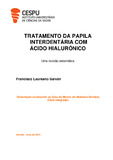| dc.contributor.advisor | MAGALHÃES, FRANCISCO JOSÉ VIEIRA DE | |
| dc.contributor.author | Galván, Francisco Laureano | |
| dc.date.accessioned | 2023-11-22T14:30:01Z | |
| dc.date.available | 2023-11-22T14:30:01Z | |
| dc.date.issued | 2023 | |
| dc.identifier.uri | http://hdl.handle.net/20.500.11816/4389 | |
| dc.description.abstract | Introdução: A importância estética e funcional da papila interdentária é representada pela porção de gengiva livre, bem como pela perda parcial ou total da papila, o que pode levar à formação de triângulos pretos interdentários que podem causar problemas estéticos, de fala e de higiene oral. O ácido hialurónico (AH), um polissacárido linear natural que desempenha vários papéis fisiológicas e estruturais na matriz extracelular do tecido conjuntivo e de outros tecidos, pode ajudar a melhorar esta situação estética e funcionais da papila interdentária.Objetivo: O objetivo do trabalho é revisar a literatura sobre a reconstrução da papila interdentária com ácido hialurônico e avaliar se é um método seguro e eficaz para melhorar a estética dos pacientes. Material e Métodos: Foi realizada uma pesquisa Pubmed de artigos publicados nos últimos 10 anos, em inglês e limitados a estudos humanos. Resultados: Foram encontrados 1010 artigos. Todos eles foram analisados de acordo com os critérios de inclusão e exclusão abaixo indicados. 19 artigos foram finalmente seleccionados. Discussão: O ácido hialurônico, desempenha vários papéis fisiológicas e estruturais na matriz extracelular do tecido conjuntivo e de outros tecidos, pode ajudar a melhorar esta situação estética e funcionais da papila. Conclusão: É ainda necessária mais investigação sobre a técnica de aplicação de ácido hialurónico à papila interdentária. No entanto, é um procedimento fácil para o médico dentário aprender e executar, bem como confortável e indolor, embora não muito duradouro para o paciente. | pt_PT |
| dc.description.abstract | Introduction: The aesthetic and functional importance of the dental papilla is represented by the portion of free gingiva, as well as the partial or total loss of the papilla. This can lead to the formation of interdental black triangles that can cause aesthetic, speech and oral hygiene problems. Hyaluronic acid, a natural linear polysaccharide that plays various physiological and structural roles in the extracellular matrix of connective tissue and other tissues can help to improve this aesthetic and functional situation of the dental papilla. Aim: The aim of this paper is to review the literature on the reconstruction of the interdental papilla with hyaluronic acid and to evaluate if it is a safe and effective method to improve the aesthetics of patients. Material and Methods: A Pubmed search was conducted of articles published in the last 10 years, in English and limited to human studies. Results: 1010 articles were found. All of them were analysed according to the inclusion and exclusion criteria below. 19 articles were finally selected. Discussion: Hyaluronic acid, which plays several physiological and structural roles in the extracellular matrix of connective tissue and other tissues, can help improve this aesthetic and functional situation of the papilla. Conclusion: More research is still needed on the technique of applying hyaluronic acid to the interdental papilla. However, it is an easy procedure for the dentist to learn and perform, as well as comfortable, painless, although not very long-lasting for the patient. | pt_PT |
| dc.language.iso | por | pt_PT |
| dc.rights | info:eu-repo/semantics/openAccess | pt_PT |
| dc.subject | Hyaluronic acid | pt_PT |
| dc.subject | Black triangles | pt_PT |
| dc.subject | Hyaluronic acid | pt_PT |
| dc.subject | Interdental | pt_PT |
| dc.subject | Theraphy | pt_PT |
| dc.subject | Dental papillae | pt_PT |
| dc.subject | Regeneration | pt_PT |
| dc.title | TRATAMENTO DA PAPILA INTERDENTÁRIA COM ÁCIDO HIALURÓNICO | pt_PT |
| dc.type | info:eu-repo/semantics/masterThesis | pt_PT |
| dc.identifier.tid | 203359119 | pt_PT |
| thesis.degree.name | Mestrado em Medicina Dentária | pt_PT |

